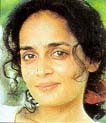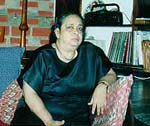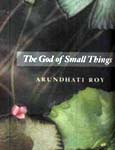|
The Rediff Special/Venu Menon
Who's Ammu?
In the week that Arundhati Roy won the Booker Prize, a fresh controversy has broken over God Of Small Things. While the author's mother Mary Roy insists that she is not Ammu, the controversial character in the novel, her estranged brother George Isaac insists she is. Venu Menon reports from Ayamanam.
 With its 'greygreen' veneer, the sluggish Meenachil river spills
straight out of the pages of God of Small Things. But Aymanam,
the somnolent village that comes alive in the book, is a picture
of still life. The Booker Price has left the village folk serenely
unmoved.
With its 'greygreen' veneer, the sluggish Meenachil river spills
straight out of the pages of God of Small Things. But Aymanam,
the somnolent village that comes alive in the book, is a picture
of still life. The Booker Price has left the village folk serenely
unmoved.
But the Corpus Christi, the school run by Arundhati's mother
Mary Roy, where the social elite of Kottayam send their children
to pick up a fashionable Western liberal education, the atmosphere
is electric. The institution has emerged as a post-Booker control
room where information about the book and its author disseminates,
where an embarrassed press corps is greeted with the query: 'Have
you read the book?"
Here is where Arundhati spent her crucial early years. It was
in this informal and somewhat avant garde setting that she discovered
the joy of reading and of going off on freewheeling explorations
of the mind. Mary Roy recalls this phase with a sense of vindication:
''She joined a formal school only at the age of eleven. I believe
that you learn much more in the absence of a rigorous syllabus.
Arundhati literally educated herself. She did not need a textbook
with an exam at the end of it. I try to do this for other kids
as well."
The Booker has unleashed a torrent of interest centering on Aymanam.
The media has been preoccupied with identifying the novel's characters
with their real-life counterparts. But in God of Small Things,
art does not mirror life. Arundhati does not have a twin brother,
did not lose her cousin in a boat mishap or grow up in her ancestral
home. Her mother is alive and well though the book pronounces
her dead. The plot is part fact, part fabrication.
But this has not discouraged speculation about skeletons in the
family cupboard. The character Ammu -- mother of the twins who
is a estranged from her Bengali husband and later has an affair
with a low-caste Hindu -- is apparently modeled on Mary Roy. ''I
am not Ammu. Arundhati has created a character called Ammu using
my bio-data as her barebones,'' Mary Roy explains.
 But George Isaac, Mary Roy's brother, who figures in the book as
Uncle Chacko, is ambiguous on the question. ''Mary Roy is Ammu,''
he contends, but declines to comment on the identity of Velutha,
Ammu's paramour, saying ''I would prefer not to answer that question."
But George Isaac, Mary Roy's brother, who figures in the book as
Uncle Chacko, is ambiguous on the question. ''Mary Roy is Ammu,''
he contends, but declines to comment on the identity of Velutha,
Ammu's paramour, saying ''I would prefer not to answer that question."
In the book, Isaac is portrayed as the England-returned uncle
who is at the vortex of the emotional tension within the family.
Issac regards his portrayal as true to life. He elaborates on
the plot: ''Mary Roy marries a Bengali which falls outside the
traditional framework of Christian marriages. That marriage collapses
and she returns to her family house with her two children in
a disturbed state of mind. They try to establish some kind of
stability in their lives. This effort centres round their uncle
Chacko. The only male in the house is me. I have to be father
to the children and, in a sense, husband to my sister."
The plot thickens when Chacko's ex-wife joins him, child in tow.
Isaac continues: ''Ammu panics and enters into a sexual relationship
with somebody outside the area of acceptability. She does something
unspeakable by Indian standards. How would you feel if your sister
panics and has an affair on the banks of the Meenachil river with
a Pulaya?''
Isaac thinks the book contains an explosive message -- ''that an
aristocratic Christian women breaks the rules by having sex with
a low caste Hindu and yet nothing happens. The universe does not
come to an end.''
 This message may not go down well with the Christian plantation
owners in their stately mansions along the banks of the Meenachil.
Curiously, this is also the strata that celebrates Arundhati's
accomplishment. ''She has put Aymanam on the world map," says Thomas
Kollenkeril, an estate owner whose wife Basil teaches at Corpus
Christi. Arundhati has been a frequent visitor and Basil recalls
the writer as being a keen observer of nature who spent long hours
watching the insects on the river bank.
This message may not go down well with the Christian plantation
owners in their stately mansions along the banks of the Meenachil.
Curiously, this is also the strata that celebrates Arundhati's
accomplishment. ''She has put Aymanam on the world map," says Thomas
Kollenkeril, an estate owner whose wife Basil teaches at Corpus
Christi. Arundhati has been a frequent visitor and Basil recalls
the writer as being a keen observer of nature who spent long hours
watching the insects on the river bank.
The book's appeal straddles the communal divide in a Christian-dominated
area like Aymanam. Professor Krishna Kaimal is an authority on
Kathakali, a temple dance form unique to Kerala. He lives close
to the Aymanam temple which figures in the novel as a pre-eminent
venue for the annual Kathakali festival. ''Arunadhati has taken
Kathakali beyond the shores of Kerala and conveyed its power
and beauty to the whole wide world,'' he gushes.
Yet to the common folk of Aymanam, Arundhati is an unfamiliar
name splashed on their consciousness by a ubiquitous media.
EARLIER FEATURES/INTERVIEWS/REPORTS:
Booker or not, Roy's in the dock
The god of small things comes bearing large gifts
'Arundhati did not write for money'
• Booker for Arundhati
• And the winner is...
• 'Ammu may have some similarities to me, but she is not Mary Roy'
• 'Why would anyone abroad be interested in the book? I am not very well educated. So it's not as though I am like Salman Rushdie or Vikram Seth'
• Obscenity case slammed against Arundhati Roy
• Now, it is EMS's turn to slam Arundhati Roy!
EXTERNAL LINKS:
• The New Masters
• Architect of Stories
• How Amazon readers reacted to the book
• The Salon Interview
•
The Booker short-list
• The Penelope Mortimer review
• The Guardian reports
Tell us what you think of this feature
|



